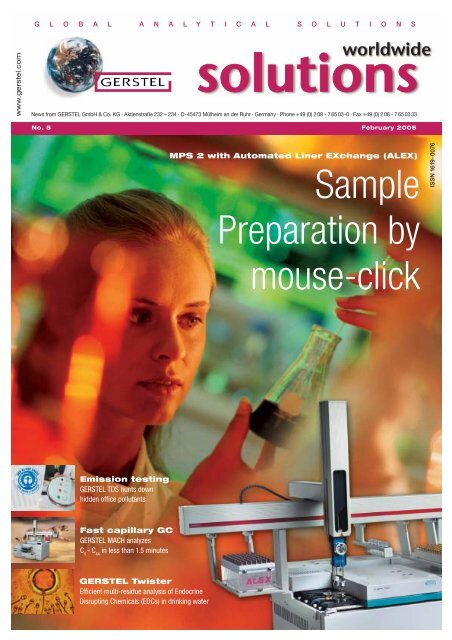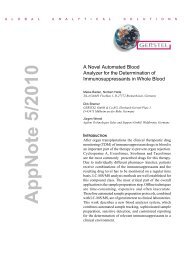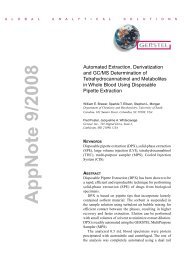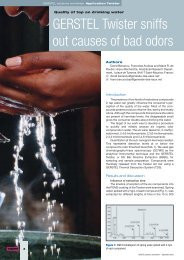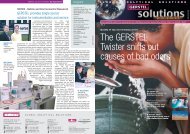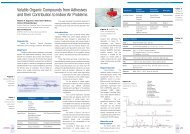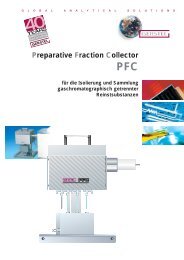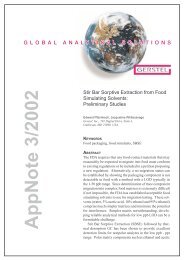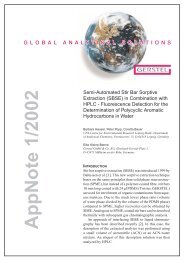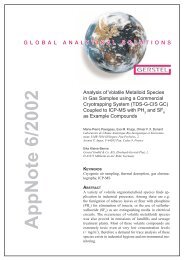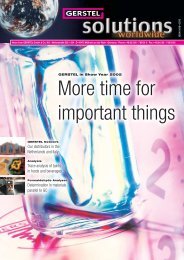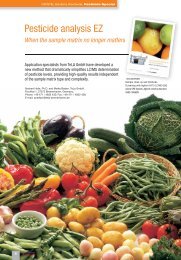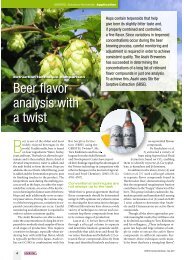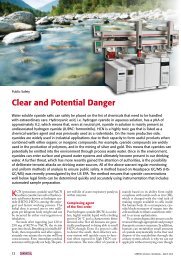GERSTEL Solutions No. 5 (pdf; 0,69 MB)
GERSTEL Solutions No. 5 (pdf; 0,69 MB)
GERSTEL Solutions No. 5 (pdf; 0,69 MB)
Create successful ePaper yourself
Turn your PDF publications into a flip-book with our unique Google optimized e-Paper software.
G L O B A L A N A L Y T I C A L S O L U T I O N S<br />
www.gerstel.com<br />
News from <strong>GERSTEL</strong> GmbH & Co. KG · Aktienstraße 232 – 234 · D-45473 Mülheim an der Ruhr · Germany · Phone +49 (0) 2 08 - 7 65 03-0 · Fax +49 (0) 2 08 - 7 65 03 33<br />
<strong>No</strong>. 5 February 2005<br />
MPS 2 with Automated Liner EXchange (ALEX)<br />
Sample<br />
ISSN 1619-0076<br />
Preparation by<br />
mouse-click<br />
Emission testing<br />
<strong>GERSTEL</strong> TDS hunts down<br />
hidden office pollutants<br />
Fast capillary GC<br />
<strong>GERSTEL</strong> MACH analyzes<br />
C 5<br />
- C 44<br />
in less than 1.5 minutes<br />
<strong>GERSTEL</strong> Twister<br />
Efficient multi-residue analysis of Endocrine<br />
Disrupting Chemicals (EDCs) in drinking water
<strong>GERSTEL</strong> solutions worldwide<br />
Report<br />
<strong>GERSTEL</strong> TDS<br />
hunts down<br />
hidden office<br />
pollutants<br />
* www.blauer-engel.de<br />
Printers and copiers emit volatile organic compounds (VOCs);<br />
some, mainly older models, generate ozone. VOCs and<br />
ozone form a reactive cocktail that can bring tears to<br />
anyone’s eyes in the office – in addition to causing<br />
wheezing, coughing and general irritation of mucus<br />
membranes. Recently, changes were made to the<br />
requirements for obtaining “Der Blaue Engel” (The Blue Angel) – the<br />
German environmental label. Copiers and printers must now meet<br />
emission standards for a whole list of VOCs that can heavily influence<br />
indoor air quality. While testing printers and copiers, the German Federal<br />
Institute of Materials Research and Testing (BAM) recently found an<br />
unexpected source of semi-volatile organic compounds (SVOCs):<br />
Recycled paper! Kaj Petersen reports.<br />
Well done to all those printers and<br />
copiers with very low emissions of<br />
chemicals – they’ve really earned the<br />
German environmental seal of approval:<br />
“Der Blaue Engel” (The Blue Angel). Recycled<br />
paper also can be given the “Blue<br />
Angel” label for being environmentally<br />
friendly if it meets test criteria specified in<br />
the German regulations for recycled paper<br />
RAL-UZ 14.<br />
A brief search of the internet confirms<br />
that the Blue Angel has been awarded to<br />
a staggering 212 types of recycled paper<br />
for various uses including copying and<br />
printing. However, printers, copiers and<br />
multi-purpose office machines that currently<br />
wear the Blue Angel badge of<br />
honor are barely mentioned. Here’s why.<br />
At the beginning of 2004, new test<br />
criteria came into force for printers and<br />
copiers. According to the German Federal<br />
Environmental Ministry, it is no longer<br />
sufficient just to test for ozone, dust and<br />
styrene emissions. As of late, testing includes<br />
how much benzene and other<br />
volatile organic compounds (VOCs) these<br />
machines emit into their environment<br />
during operation. Based on an article released<br />
by the German Federal Institute of<br />
Materials Research and Testing (BAM),<br />
the question arises whether current test<br />
criteria for granting the Blue Angel for<br />
recycled paper are adequate, or if they<br />
are due for revision as is the case for<br />
printers and copiers.<br />
Thermal Desorption using the<br />
<strong>GERSTEL</strong> TDS led to the<br />
discovery<br />
While performing emissions testing<br />
using environmental test chambers, the<br />
BAM scientists came across not only<br />
VOCs emitted from laser printers and<br />
copiers, but also large amounts of semivolatile<br />
organic compounds (SVOCs)<br />
that were not emitted from the machines<br />
themselves. Further detailed testing revealed<br />
the source of the emissions: The<br />
recycled paper being used.<br />
The analytical method used for emissions<br />
testing of printers and copiers is<br />
based on the Standard Method 328 from<br />
the European Computer Manufacturers<br />
Association (ECMA). The ECMA 328<br />
method was developed to measure VOC<br />
emissions from electronic and semiconductor<br />
products in order to determine the<br />
impact of such products on indoor air. A<br />
<strong>GERSTEL</strong> Thermal Desorption System<br />
(TDS) in combination with a <strong>GERSTEL</strong><br />
Cooled Injection System (CIS) is required<br />
in order to comply with the ECMA 328<br />
method parameters.<br />
<strong>GERSTEL</strong> solutions worldwide – February 2005<br />
2
<strong>GERSTEL</strong> solutions worldwide<br />
Report<br />
To track down the source of SVOC<br />
emissions from the recycled paper, the<br />
BAM scientists relied on the <strong>GERSTEL</strong><br />
TDS 2 and direct thermal extraction inside<br />
the TDS tube.<br />
The paper was cut into strips that<br />
were placed inside TDS tubes and subsequently<br />
thermally extracted. The tubes<br />
were heated to 180°C inside the TDS 2 in<br />
a flow of inert gas that is used to transfer<br />
extracted VOCs and SVOCs to the GC<br />
for analysis. The desorption temperature<br />
was set at 180°C since this is the temperature<br />
used for toner fixation in laser<br />
printers and copiers.<br />
An efficient and inexpensive<br />
alternative to environmental<br />
test chambers<br />
As emission measurements of various<br />
solids have already shown (see page<br />
4), direct thermal extraction leads to results<br />
comparable to those coming from<br />
environmental test chambers under<br />
properly controlled conditions.<br />
The main difference is that emissions<br />
can be determined<br />
much more easily –<br />
and much less expensively<br />
– using direct<br />
thermal extraction.<br />
Using the TDS to<br />
determine materials<br />
emissions requires<br />
Kaj Petersen only small amounts of<br />
Marketing Manager, sample (approximately<br />
5-12 mg).<br />
<strong>GERSTEL</strong> GmbH & Co. KG.<br />
The sample to be<br />
analyzed is placed inside the TDS tube,<br />
which is then transferred to the<br />
<strong>GERSTEL</strong> TDS 2. Thermal extraction<br />
takes place by heating the tube and<br />
sample inside the TDS 2 in a flow of inert<br />
carrier gas. Emitted analytes are swept<br />
from the TDS to the <strong>GERSTEL</strong> CIS 4,<br />
where they are concentrated prior to GC/<br />
MS analysis. Following the thermal extraction<br />
and concentration step, the CIS<br />
4 is rapidly heated and analytes are<br />
transferred to the GC column for separa-<br />
Official documentation in English is available from BAM for the Blue Angel<br />
test-method for printers and copiers: Text 88/03; ISSN 0722 186X<br />
“Development of a test method for an investigation into limiting the emissions<br />
from printers and copiers within the framework of assigning the<br />
environmental label”. The official test method is included: “Test Method for<br />
the determination of emissions from hardcopy devices with respect to<br />
awarding the environmental label for office devices RAL-UZ 62, RAL-UZ 85<br />
and RAL-UZ 114. (BAM, June 2003)”. Further information:<br />
Werbung und Vertrieb, Wolframstraße 95-96, 12105 Berlin, Germany,<br />
fax: +49 30 218 13 79; E-mail: berlin@wundv.com.<br />
tion and mass spectrometric (MS) detection.<br />
Using this method, emitted organic<br />
compounds are easily identified and<br />
quantified.<br />
When the BAM scientists analyzed<br />
the recycled paper, they found not only<br />
VOCs, but also SVOCs, including isopropyl<br />
laurate – an ink binding agent – and<br />
isopropyl naphthalene.<br />
According to the scientists, these<br />
chemicals are probably residues of printing<br />
inks applied to the original recycled<br />
paper.<br />
However, not only was the presence<br />
of SVOCs surprising, but also the<br />
amount: Depending on the printer or<br />
copier, up to ten times more SVOCs than<br />
VOCs were emitted.<br />
A further aspect: Modern printers<br />
may produce little or no ozone, but many<br />
offices still have older equipment. Ozone<br />
reacts readily with unsaturated organic<br />
compounds to form free radicals that are<br />
known to irritate the eyes and respiratory<br />
tract even at low concentrations.<br />
Reduce the temperature of the<br />
printing process or get rid of<br />
the chemicals<br />
Perhaps one should not be overly<br />
concerned, but the BAM scientists still<br />
believe the emission of SVOCs from printing<br />
and copying with recycled paper<br />
needs monitoring.<br />
The scientists have the following suggestions:<br />
Inks and toners should be developed<br />
that enable fixation to take place<br />
at lower temperatures. In addition, only<br />
printing inks should be used that can easily<br />
be removed from paper in the recycling<br />
process.<br />
Questions still remain about what to<br />
do with recycled papers that have already<br />
been awarded the Blue Angel label.<br />
Should these be allowed to keep their<br />
stamp of approval in spite of these new<br />
findings, or should the supposedly environmentally<br />
friendly paper share the same<br />
fate as printers and copiers and be sent<br />
back to the environmental test bench?<br />
The environmental labelling agency<br />
will have to come up with an answer. It is<br />
safe to say that if the rules for awarding<br />
the Blue Angel are tightened, then direct<br />
thermal extraction using the <strong>GERSTEL</strong><br />
TDS will enable the efficient and sensitive<br />
determination of VOC and SVOC emissions<br />
according to the new regulations.<br />
The TDS is a proven tool for determining<br />
emissions from not only paper, as<br />
in this case, but also from solid materials<br />
in general and from viscous samples<br />
such as sealants and glues.<br />
In This Issue<br />
Report<br />
<strong>GERSTEL</strong> TDS hunts down hidden<br />
office pollutants 2<br />
Material emission<br />
testing<br />
Direct thermal extraction vs.<br />
Emission test chamber 4<br />
Analysis<br />
Chemometrics - efficient evaluation and<br />
classification of chromatograms 6<br />
Innovation<br />
• MACH - Analysis of C 5<br />
-C 44<br />
in less<br />
than 1.5 minutes 8<br />
• TWISTER - efficient determination<br />
of EDCs in drinking water 10<br />
Distributors<br />
Anatune Ltd. Appointed <strong>GERSTEL</strong><br />
Distributor in the UK and Ireland 12<br />
<strong>GERSTEL</strong> worldwide<br />
• <strong>GERSTEL</strong> K.K. established in Japan<br />
• Partnership with RVM Scientific<br />
• 250th TDS sold in Japan 13<br />
Automation<br />
MPS 2 – optimized, automated<br />
GC analysis 14<br />
Software<br />
Sample Preparation by mouse-click –<br />
easier than ever 16<br />
Application<br />
Automated Liner EXchange<br />
for GC injectors. New technology<br />
for handling dirty samples 17<br />
<strong>GERSTEL</strong><br />
at PittCon 2005 20<br />
<strong>GERSTEL</strong> solutions worldwide – February 2005<br />
3
<strong>GERSTEL</strong> solutions worldwide<br />
Material emission testing<br />
Direct thermal extraction vs. emission test chambers<br />
Fast and reliable determination of<br />
emissions from carpet adhesives<br />
Upholstery, carpeting, adhesives, sealants, paints and various building<br />
materials can contain and emit volatile organic compounds (VOCs) and<br />
semi-volatile organic compounds (SVOCs), which impact indoor air quality<br />
and can contribute to “sick building syndrome” (SBS).<br />
SBS is a term used when bad indoor air quality leads to health problems or<br />
even illness among occupants. In order to test materials used inside our<br />
homes and workplaces, their VOC and SVOC emissions are determined<br />
using an emission test chamber under controlled conditions. Direct<br />
thermal extraction with the <strong>GERSTEL</strong> Thermal Desorption System (TDS)<br />
leads to comparable results, as testing of carpet adhesives shows.<br />
Figure 1<br />
Loading a 1 m 3<br />
test chamber<br />
with adhesive on<br />
glass plates<br />
Figure 2<br />
<strong>GERSTEL</strong> TDS 3<br />
and TDS A with<br />
samples for<br />
direct thermal<br />
extraction<br />
Emission testing of materials is generally<br />
performed in test chambers. An<br />
emission profile is generated over a period<br />
of 28 days under well-defined conditions.<br />
This process is time-consuming<br />
and extremely costly. The process can be<br />
simulated by direct thermal extraction: A<br />
large number of extractions are performed<br />
in a much smaller volume and<br />
over a much shorter period of time.<br />
Thermal extraction is an extremely<br />
efficient method for determining the<br />
emission potential of a material or product,<br />
for example, in the development<br />
phase. To perform a thermal extraction<br />
determination using the <strong>GERSTEL</strong> TDS,<br />
only 5 to 20 mg sample is required. The<br />
sample is introduced into a TDS glass<br />
tube and then heated to the specified<br />
temperature in a controlled gas flow (he-<br />
Authors<br />
Olaf Wilke Ph.D., Oliver Jahn Ph.D. and Doris<br />
Brödner, Federal Institute for Materials<br />
Research and Testing (BAM), Germany<br />
lium) to simulate test chamber conditions.<br />
Determination of the analytes is<br />
performed by GC/MS.<br />
Emission Test Chamber<br />
The Emission test chambers used for<br />
analysis of the adhesives comply with the<br />
European standard EN 13419-1.<br />
The operating temperature was kept<br />
at 23 ± 0.5°C, the relative humidity<br />
50 ± 3 % and the area-specific air<br />
flow rate set to q = 1.25 m 3 /m 2 h (loading<br />
0.4 m 2 /m 3 , air exchange 0.5 h-1 ).<br />
Chamber air sampling<br />
Air sampling from the test chamber<br />
was performed using <strong>GERSTEL</strong> TDS<br />
glass tubes (length 178 mm, outside diameter<br />
6 mm, inside diameter 4 mm),<br />
filled with Tenax TA (200 mg, 60/80<br />
MESH) mounted with plugs of deactivated<br />
glass wool. Between 1 and 2 L of<br />
chamber air was sampled at a flow of 100<br />
mL/min.<br />
Just before the sample was drawn,<br />
the glass wool was spiked with 1 µL internal<br />
standard containing cyclodecane in<br />
methanol. For calibration, a blank tube<br />
was spiked with 1 µL of a standard mixture<br />
in methanol. After adding the internal<br />
4<br />
<strong>GERSTEL</strong> solutions worldwide – February 2005
<strong>GERSTEL</strong> solutions worldwide<br />
Material emission testing<br />
Figure 3 Chromatograms from test chamber air<br />
analysis after 24 hours (left) and from direct thermal<br />
extraction analysis after 1 h (right)<br />
standard, 1 L of clean air from an empty<br />
emission test chamber was drawn through<br />
the tube to purge out the methanol.<br />
Analysis of the Chamber Air<br />
The analysis was performed by thermal<br />
desorption GC/MS using a TDS 2<br />
coupled to a GC 5890 II Plus / MSD 5972<br />
GC/MS system. The thermal desorption<br />
conditions were: Heating from 40°C to<br />
280°C at 40°C/min, hold time 5 minutes at<br />
280°C. Cryofocussing at -150°C in the<br />
<strong>GERSTEL</strong> Cooled Injection System (CIS 3).<br />
Helium desorption flow 20 mL/min. Following<br />
tube desorption, the CIS 3 was<br />
heated to 280°C at a rate of 12°C/s in<br />
splitless mode to transfer the analytes to<br />
the GC column. A Restek Rtx-200 column<br />
was used, length 30 m, film thickness 1 µm,<br />
i.d. 0.25 mm.<br />
Direct Thermal Extraction<br />
Using a spatula, the adhesives were<br />
applied to aluminum foil between two<br />
adhesive strips, which were used to get a<br />
defined film thickness.<br />
After 1 hour of drying, a small strip (3<br />
mm x 20 mm) with 5-10 mg of adhesive<br />
was cut out and transferred to an empty<br />
glass TDS tube. Thermal extraction was<br />
performed at 23°C for 12.5 minutes under<br />
a helium flow of 20 mL/min. Multiple thermal<br />
extractions were performed by repeating<br />
the extraction at the end of each<br />
GC run, enabling a rate of one extraction<br />
per hour.<br />
Between extractions, the glass tube<br />
containing the adhesive was sealed airtight<br />
by the <strong>GERSTEL</strong> TDS A autosampler<br />
(Fig. 2). The only difference in analysis<br />
parameters from the chamber air analysis<br />
is that the TDS 2 temperature is kept constant<br />
at 23°C for thermal extraction.<br />
Results<br />
The chromatograms in Figure 4 show<br />
that direct thermal extraction and test<br />
chamber measurements for flooring adhesives<br />
yield comparable results. Chromatograms<br />
obtained with the two methods<br />
show the same compounds and peak<br />
pattern. Our results also show that multiple<br />
thermal extraction can simulate the<br />
long term emission behavior of a material<br />
measured in a test chamber.<br />
Discussion<br />
The method of direct thermal extraction<br />
was first used at higher temperatures<br />
(up to 200°C) as a screening tool for VOC<br />
and SVOC emissions from building products.<br />
The results for flooring adhesives<br />
show that keeping the temperature at<br />
23°C, as in the chamber experiments,<br />
gives a good correlation to the chamber<br />
measurements.<br />
The differences between test chamber<br />
measurement and direct thermal extraction<br />
using a TDS are the gas used, the<br />
different specific flow rate (q) and the<br />
mass of the applied adhesive. In the<br />
chambers, humidified air is used with q =<br />
1.25 m 3 /m 2 h and 300 g/m 2 adhesive applied.<br />
For direct thermal extraction, helium<br />
is used with q = 20 m 3 /m 2 h with 100 g/m 2<br />
adhesive applied. These parameters are<br />
compensated by using different test<br />
times: 1 hour after application for thermal<br />
extraction, 24 hours after application for<br />
chamber measurements. Using the TDS<br />
for direct thermal extraction analysis of<br />
inhomogeneous or thick materials such<br />
as floor coverings showed no such correlation<br />
to test chamber measurements.<br />
When using 4 mm i.d. tubes for thermal<br />
extraction, test conditions such as emitting<br />
surfaces and edges are too different.<br />
For inhomogeneous or thicker materials,<br />
we will test the <strong>GERSTEL</strong> Thermal Extractor<br />
TE 2 with its larger 14 mm i.d. extraction<br />
tube.<br />
Toyota uses <strong>GERSTEL</strong><br />
TE 2 for materials<br />
emission testing<br />
When leading automobile manufacturers<br />
and their suppliers world-wide perform<br />
materials emission testing, they turn to<br />
a method from the German association of<br />
car manufacturers (VDA). Before a material is<br />
accepted for use in a car interior, it is tested<br />
for emission of volatile organic compounds<br />
(VOCs) as well as for emission of organic<br />
compounds in the boiling point range corresponding<br />
to the range from n-C 16<br />
to n-C 32<br />
.<br />
The amount of higher-boiling compounds<br />
in a material is expressed in a socalled<br />
fog-value, a name derived from condensation<br />
of these compounds forming a<br />
film on the windshield (fogging).<br />
The VDA 278 method describes the<br />
“thermal desorption analysis of organic<br />
emissions for the characterization of nonmetallic<br />
materials used in automobiles”.<br />
The method is based on the use of<br />
the <strong>GERSTEL</strong> Thermal Desorption System<br />
(TDS 2) that incorporates the <strong>GERSTEL</strong><br />
Cooled Injection System (CIS 4) as well as a<br />
twenty position autosampler.<br />
TDS tubes, which are used for the VDA<br />
278 method, have an internal diameter of 4<br />
mm. Sample size is thus limited, making it<br />
difficult to analyze representative samples of<br />
foams, molded plastics and inhomogenous<br />
materials.<br />
Toyota has now optimized the VDA 278<br />
method for larger samples by using the<br />
<strong>GERSTEL</strong> Thermal Extractor (TE 2) with its<br />
larger inner tube for the thermal extraction<br />
step. Thanks to the larger internal diameter<br />
of its extraction tube, the <strong>GERSTEL</strong> TE 2<br />
facilitates direct thermal extraction of a representative<br />
sample amount.<br />
Thermal extraction is performed at temperatures<br />
that could be encountered in your<br />
car interior when parked in direct sunlight on<br />
a warm summer’s day.<br />
<strong>GERSTEL</strong> solutions worldwide – February 2005<br />
5
<strong>GERSTEL</strong> solutions worldwide<br />
Analysis<br />
Yes/no. Good/ bad:<br />
Chemometrics offer efficient<br />
evaluation and classification of chromatograms.<br />
When you need<br />
a fast decision<br />
Author<br />
Carlos Gil<br />
Product Manager Chemometrics<br />
<strong>GERSTEL</strong> GmbH & Co. KG<br />
chemsensor@gerstel.de<br />
You are faced with a substantial number of chromatograms, and<br />
want to know which ones fall into certain classes, for example<br />
good or bad, ship or hold. What do you do? <strong>No</strong>rmally, you would<br />
download the data to your chromatography data handling<br />
software, generate a peak area report for each chromatogram,<br />
and begin the process of comparing the reports - a laborious<br />
and tedious process. The exploratory analysis of reduced data<br />
could make your work significantly easier.<br />
Chromatography data analysis is normally<br />
performed based on the peak areas<br />
of identified compounds or on area percent<br />
reports. Especially in the case of<br />
complex chromatograms, evaluation and<br />
classification becomes a difficult and<br />
time-consuming exercise that requires<br />
highly qualified and experienced personnel.<br />
There are alternatives, however, especially<br />
when quick decisions are needed,<br />
for determining whether a sample is<br />
good or bad or whether it can be shipped,<br />
yes or no.<br />
Chemometric analysis using pattern<br />
recognition algorithms can provide clear<br />
answers quickly and easily. The data<br />
analysis procedure can be fully automated.<br />
Chromatograms and/or mass<br />
spectra of samples are subjected to a<br />
sophisticated screening process and only<br />
outliers subsequently need to be evaluated<br />
in the traditional way.<br />
<strong>GERSTEL</strong> offers chemometrics software<br />
packages – either within the scope<br />
of a complete analytical solution package,<br />
or as a retrofit for existing systems.<br />
<strong>GERSTEL</strong> co-operates with Infometrix,<br />
one of the leading developers of<br />
chemometric software, as well as with<br />
Agilent Technologies, a leading manufacturer<br />
of analytical systems.<br />
Complete Solution Packages:<br />
The <strong>GERSTEL</strong> ChemSensor<br />
Systems<br />
The product family of the <strong>GERSTEL</strong><br />
ChemSensors is far superior to conventional<br />
electronic noses. By coupling an<br />
autosampler directly to a mass spectrometer,<br />
a highly flexible analytical system is<br />
produced with a large number of fully independent<br />
sensors: every detected variable<br />
(m/z) is equivalent to the sensor of a<br />
conventional electronic nose. Apart from<br />
this, the ChemSensor offers the user the<br />
possibility of correlating both GC/MS<br />
data and their chemometric evaluation.<br />
The principle of chemometric evaluation<br />
is based on reducing 3-dimensional<br />
data (intensity, fragment m/z and retention<br />
time) acquired with the mass-selective<br />
detector (MSD) to two dimensions.<br />
This means that either the total combined<br />
mass spectrum of the sample over the<br />
course of the analysis, also called the<br />
fingerprint mass spectrum (intensity vs.<br />
m/z) or the total ion current chromatogram<br />
(TIC intensity vs. retention time) is<br />
used.<br />
ChemSensor: Fingerprint Mass<br />
Spectrum without GC<br />
Separation<br />
The ChemSensor is the MS-only configuration.<br />
It comes with an interface<br />
through which samples can be directly<br />
injected into the MSD – without chromatographic<br />
separation. The injection is<br />
done via the <strong>GERSTEL</strong> Cooled Injection<br />
System (CIS 4 Plus), which can be operated<br />
in split and splitless modes using<br />
various injection techniques. In combination<br />
with the <strong>GERSTEL</strong> MultiPurpose<br />
Sampler (MPS 2) (cf. pp 14-15), either<br />
headspace injection or solid phase<br />
microextraction (SPME) can be applied.<br />
As compounds are not separated,<br />
retention times are irrelevant. The influence<br />
of retention time is removed from<br />
the data by summing up the intensities of<br />
m/z value over the complete time period<br />
of the run. The evaluation is performed<br />
based on fingerprint mass spectra.<br />
ChemSensor System:<br />
Fingerprint Mass Spectrum plus<br />
GC Separation<br />
The ChemSensor System consists of<br />
a GC coupled with a Mass Spectrometer.<br />
The sample is injected via a conventional<br />
GC, not through the ChemSensor inter-<br />
<strong>GERSTEL</strong> solutions worldwide – February October 2005 2004<br />
6
<strong>GERSTEL</strong> solutions worldwide<br />
Analysis<br />
face. The ChemSensor system can be<br />
operated both as a ChemSensor and as<br />
a conventional GC/MS system with free<br />
choice of the injection technique. The<br />
system is extremely flexible: During<br />
ChemSensor operation, the column is<br />
mainly kept isothermal (hot) and serves<br />
as a transfer capillary. Samples identified<br />
as outliers can be investigated further by<br />
performing a full GC/MS analysis using<br />
the system in exactly the same configuration.<br />
For ChemSensor operation, chromatographic<br />
separation is irrelevant, and<br />
analyte retention is minimal. The aim is to<br />
reduce analysis time and increase sample<br />
throughput. Chromatograms, though, are<br />
helpful for closer investigation of outliers.<br />
If a GC separation is performed, the<br />
ChemSensor software can be used to<br />
evaluate both the fingerprint mass spectrum<br />
and the total ion chromatogram<br />
(TIC) profile. The TIC profile shows the<br />
total intensity of all fragments as a function<br />
of the retention time.<br />
Pirouette Software for<br />
Chemometric Analysis<br />
Regardless of how the user reduces<br />
the data (intensity vs. m/z or TIC intensity<br />
vs. retention time), the result is a two-dimensional<br />
matrix. Using the Pirouette<br />
Software, the data can be depicted as a<br />
line plot and normalised.<br />
Chemometric analysis is based on linear<br />
combinations of the original variables<br />
(m/z values or retention times). The data<br />
is listed in the columns of the data tables.<br />
The first step after visualizing the data is<br />
an exploratory analysis employing two<br />
algorithms: hierarchical cluster analysis<br />
(HCA) and principal component analysis<br />
(PCA).<br />
The aim is to identify groups within<br />
the data, and to determine whether classifications<br />
can be established. PCA<br />
searches simultaneously for correlations<br />
between all variables, and extracts linear<br />
combinations of strongly correlated variables,<br />
the so-called principal components,<br />
which describe the main variability<br />
of the sample. The PCA Scores Plot (Figure<br />
1) shows quickly and simply which<br />
samples are similar and which fall outside<br />
the pattern.<br />
In parallel to the exploratory analysis,<br />
two further algorithms are used to construct<br />
the classification models and assign<br />
unknown samples to the groups:<br />
K Nearest Neighbors (KNN) and the socalled<br />
SIMCA (Soft Independent Modelling<br />
of Class Analogy) algorithms.<br />
KNN classifies unknown samples depending<br />
on their proximity to samples<br />
already assigned to categories (classes),<br />
whereas SIMCA uses principal component<br />
analysis (PCA) to model the position<br />
and distribution of the samples. Classifications<br />
of this type can be automated<br />
with the ChemSensor software.<br />
Figure 1 PCA Scores Plot<br />
Rapid Data Interpretation<br />
For existing Agilent GC/MS systems,<br />
the Rapid Data Interpretation Software is<br />
a convenient add-on tool that implements<br />
many ChemSensor features. Its<br />
main application is to search datasets for<br />
outliers or to investigate the natural<br />
grouping of samples based on the fingerprint<br />
mass spectrum or on the TIC profile.<br />
A Pirouette Lite Explore software is included,<br />
comprising the HCA and PCA<br />
algorithms.<br />
<strong>GERSTEL</strong> ChemSensor System<br />
Chemometric Analysis of GC<br />
and LC Data from non-MS<br />
detectors<br />
GC and LC data based on detectors<br />
other than mass spectrometric can also<br />
be analyzed and classified using automated<br />
chemometric analysis. The analysis<br />
can be based on either a peak table or<br />
raw data (intensity vs. retention time).<br />
When using raw data, which is normally<br />
acquired at a high sampling rate, it is advisable<br />
to reduce the number of datapoints<br />
(bunching).<br />
GC and LC Retention Time<br />
Correction<br />
Concentration differences, ageing of<br />
the column and changes in carrier gas<br />
flow are factors that can cause a shift in<br />
retention time. To compensate for this,<br />
the Agilent Technologies Retention Time<br />
Locking (RTL) software can be employed.<br />
Alternatively, the new InfoMetrix LineUp<br />
software, Version 2.0 can perform purely<br />
software-based corrections. The software<br />
uses a multivariate correlation<br />
method to shift and align the retention<br />
time axis of a chromatogram with a reference<br />
chromatogram. LineUp supports<br />
various file formats, for instance Agilent<br />
ChemStation (*.CH files) and AIA data interchange<br />
format (*.CDF files). In combination<br />
with the ChemStation, this process<br />
can be automated.<br />
<strong>GERSTEL</strong> solutions worldwide – October February 2004 2005<br />
7
<strong>GERSTEL</strong> solutions worldwide<br />
Innovation<br />
Modular Accelerated Column Heater for fast Capillary GC<br />
Analyze C 5<br />
– C 44<br />
in less<br />
than 1.5 minutes<br />
Increased efficiency,<br />
increased sample<br />
throughput, lower<br />
operating expenses –<br />
there are many<br />
reasons why GC labs invest in new technology. Often this<br />
requires a sizeable investment, which can be a stumbling<br />
block in itself – but that doesn’t have to be the case –<br />
as the following report demonstrates.<br />
In addition to financial aspects,<br />
changes in laboratory equipment and<br />
techniques often involve worrying about<br />
parting with established methods and<br />
investing valuable energy into developing<br />
and validating new methods. Such<br />
changes need not be of great concern to<br />
users of Agilent Technologies 6890 GCs,<br />
says Ralf Bremer, general manager of<br />
<strong>GERSTEL</strong> GmbH & Co. KG in Mülheim an<br />
der Ruhr, Germany.<br />
<strong>GERSTEL</strong> offers its customers a new<br />
heating module that is quickly retro-fitted<br />
to the 6890 GC, increasing the efficiency<br />
of the system and cutting operating costs<br />
at the same time. The analytical method<br />
is left almost unchanged, ensuring a<br />
smooth transition. The Modular Accelerated<br />
Column Heater (MACH) significantly<br />
increases sample throughput while requiring<br />
only 1% of the power needed to<br />
operate a conventional GC oven in temperature-programmed<br />
mode.<br />
Separation of a mixture of hydrocarbons<br />
covering a wide boiling-range from<br />
n-C5 to n-C44- alkanes is performed in as<br />
little as 1.5 minutes. Rather than develop-<br />
ing all new GC methods, the user just has<br />
to perform slight modifications. <strong>No</strong> new<br />
injector or detector is needed. “The only<br />
thing the user has to get used to”, says<br />
Bremer ”is the speed at which the GC<br />
system gets ready for the next analysis”.<br />
MACH was developed by RVM Scientific<br />
Inc., located in the United States.<br />
MACH is based on LTM technology, as<br />
Robert Mustacich Ph.D. of RVM explains.<br />
The acronym LTM stands for Low Thermal<br />
Mass, a term which aptly describes<br />
why the module temperature can quickly<br />
be changed using very little energy.<br />
The module contains almost no insulation<br />
material or void volumes which<br />
would have to be heated or cooled over<br />
the course of a temperature program. “<strong>No</strong><br />
energy is wasted, the module heats and<br />
cools extremely fast and is quickly ready<br />
for the next analysis”, says Mustacich.<br />
“The concept of the MACH heating<br />
module is quite simple: A heating wire<br />
and a sensor wire run parallel to the entire<br />
capillary column. The temperature is<br />
measured over the entire length of the<br />
column and a thin ceramic insulation<br />
Figure 1. MACH GC Module based on<br />
Low Thermal Mass (LTM ) technology<br />
(covers removed); Inside, the specially<br />
packaged column can be seen along with<br />
the heated transfer line connectors and<br />
high-temperature interface. The 3.5‘‘<br />
Floppy Disk is shown for size comparison.<br />
layer prevents short circuits in the heating<br />
wire, ensuring an even temperature profile<br />
over the complete length of the column”,<br />
explains Mustacich.<br />
“The column and heating-wires are<br />
wound together in a coil and wrapped<br />
tightly with metal foil. In essence, LTM<br />
technology is a kind of repackaging<br />
method, realized within the smallest<br />
space. The use of energy for heating and<br />
cooling is reduced to a minimum, and the<br />
heating/cooling speeds are increased to<br />
a maximum – at the same time making<br />
sure that all commercially available capillary<br />
columns of any length can be used”,<br />
says Mustacich.<br />
8<br />
<strong>GERSTEL</strong> solutions worldwide – February 2005
<strong>GERSTEL</strong> solutions worldwide<br />
Innovation<br />
“The spatial construction of the LTMsystem<br />
is far more efficient than, for example,<br />
two-dimensionally etched tubes<br />
in planar substrates”, explains the developer.<br />
Due to the low surface area, the heat<br />
loss in MACH is negligibly small, which,<br />
by the way, is especially noticeable for the<br />
user in summer. Mustacich: “Room temperature<br />
in the lab is less influenced by<br />
MACH GC operation, reducing the need<br />
for air conditioning and consequently reducing<br />
your utility bills.”<br />
The analysis requires less energy, yet<br />
the temperature program runs much<br />
faster than in standard gas chromatographs.<br />
“The amount of energy needed to<br />
heat an 18 m fused silica capillary column<br />
with a diameter of 0.32 mm from 40 to<br />
400°C with a ramp rate of 60°C/min is<br />
only 23 Watts, i.e. only 1.3 W/m of column”,<br />
says Mustacich.<br />
MACH is cooled by ambient air using<br />
fans that are mounted in the module below<br />
the column. A fused silica column of<br />
2 m length with an inside diameter of 0.10<br />
mm, used for example with GC/Time-of-<br />
Flight MS, cools from 350°C to 50°C in 30<br />
seconds, dramatically reducing the cooldown<br />
time when compared to a traditional<br />
GC instrument. This leads to better<br />
productivity and much improved return<br />
on investment for the complete system.<br />
Cool-down in an LTM module for a 15<br />
m column with an inside diameter of 0.32<br />
mm from 350°C to 50°C takes 140 seconds.<br />
Due to its low thermal mass and<br />
fast cool-down, fused silica capillary columns<br />
are preferred, but short metal capillary<br />
columns with a diameter of 0.53 mm<br />
can also be used.<br />
Upgrading an existing GC takes<br />
only a few moments<br />
MACH is mounted on the outside of<br />
the GC using a special replacement oven<br />
door. Mounting on the outside instead of<br />
inside the GC oven has distinct advantages,<br />
Bremer explains:<br />
Figure 2. Two MACH<br />
modules installed in<br />
the oven door of an<br />
Agilent Technologies<br />
6890 GC.<br />
Figure 3. Fast GC analysis of<br />
C5 to C44 n-alkanes using LTMtechnology<br />
(Data kindly provided<br />
by Separation Systems Inc., Gulf<br />
Breeze, FL, U.S.A.).<br />
Figure 4. %RSD for Alkane-Retention times comparing the MACH System with<br />
an Agilent 6890 GC using the same GC column.<br />
“The GC oven can be operated isothermally<br />
at the maximum temperature<br />
needed for the analysis.” This means that<br />
no special steps have to be taken to heat<br />
injector and detector connections inside<br />
the oven.<br />
The oven door with the integrated<br />
control module can be exchanged very<br />
quickly. One control module operates up<br />
to four MACH column modules, which<br />
can be programmed independently of<br />
each other, Bremer explains, and continues:<br />
“In multi-column applications, the<br />
GC separation on each column can be<br />
optimized independently without affecting<br />
other columns. The user is not forced<br />
to work with a single temperature program<br />
for all columns.”<br />
Running a MACH analysis is exactly<br />
like running a standard GC analysis; there<br />
is no difference in how the GC is operated.<br />
“The system is highly transparent to<br />
the host GC, the user can continue to<br />
work with the same software, injectors<br />
and detectors as before”, says Bremer,<br />
and adds: “ Everything is comfortably operated<br />
from the ChemStation from Agilent<br />
Technologies using just one method and<br />
just one sequence list.”<br />
<strong>GERSTEL</strong> solutions worldwide – February 2005<br />
9
<strong>GERSTEL</strong> solutions worldwide<br />
Innovation<br />
Twister provides efficient<br />
multi-residue analysis of<br />
endocrine disrupting<br />
chemicals in drinking water<br />
In the early 1990s a discovery stirred<br />
up the scientific community: The quality<br />
of human sperm was found to have seriously<br />
deteriorated over a period of 50<br />
years. Millions of dollars were subsequently<br />
invested in research to determine<br />
the causes, with researchers initially focusing<br />
on synthetic hormones used in<br />
contraceptive pills. Such hormones are<br />
excreted in urine and returned to the environment<br />
through the sewage system.<br />
Soon, another group of chemicals was<br />
under scrutiny: Endocrine Disrupting<br />
Chemicals (EDCs). EDCs include a wide<br />
range of chemicals such as some pesticides,<br />
industrial chemicals, polycyclic<br />
aromatic hydrocarbons (PAHs), polychlorinated<br />
biphenyls (PCBs), and several<br />
other types of compounds.<br />
EDCs are suspected of blocking or<br />
replicating the functions of natural hormones,<br />
with negative impact on reproduction,<br />
development and growth in a<br />
variety of organisms. Unfortunately, a lot<br />
of proof has been found in real-life<br />
samples in our environment.<br />
“In sole and codling, PCBs caused<br />
atrophy of the ovaries, and reduced fertility<br />
in male fish. Similar effects were discovered<br />
in mink, otter, beluga whales and<br />
in seals”, says Oliver Lerch, Ph.D., application<br />
chemist at <strong>GERSTEL</strong>. Lerch wrote<br />
his dissertation on “Automated Detection<br />
of Endocrine Disrupting Substances<br />
by GC/MS” at the Ruhr University in<br />
Bochum, Germany.<br />
While the negative influence of EDCs<br />
on wildlife is considered proven, there is<br />
little concrete proof of negative effects on<br />
humans. Still, reports on infertility, prostate-,<br />
testicular-, and breast-cancer, retarded<br />
intellectual development in children<br />
or premature puberty, point time<br />
and time again to influence of EDCs,<br />
which reach us in food and drinking water.<br />
Due to the severe consequences, the<br />
mere suspicion of a possible threat is<br />
considered enough justification for banning<br />
suspected EDC type pollutants.<br />
Food and drinking water needs to be<br />
thoroughly analyzed for traces of EDC<br />
compounds. From a list of 553 suspected<br />
EDC agents, 300 potential active<br />
compounds have been identified.<br />
According to the German Drinking<br />
Water Regulation (TrinkW2001), which is<br />
based on the EU Drinking Water Regulations<br />
(98/83/CE), the maximum allowable<br />
concentration for any single EDC compound<br />
is 0.10 µg/L and the sum of all<br />
EDC compounds is not allowed to exceed<br />
0.50 µg/L.<br />
Reliable determination of<br />
different EDC classes<br />
Some screening and analytical methods<br />
for a limited number of EDCs are<br />
available. Analytical laboratories are, of<br />
course, looking for efficient multi-residue<br />
EDC analytical methods. These need to<br />
cover as many target compounds as<br />
possible, using only one sample preparation<br />
method and one chromatographic<br />
technique. Equally, labs are striving to<br />
eliminate or reduce the use of toxic solvents<br />
such as acetonitrile for sample<br />
preparation.<br />
According to Lerch, existing methods<br />
for the detection of EDCs are based on<br />
solid phase extraction (SPE) or liquid-liquid<br />
extraction (LLE) which require relatively<br />
large volumes of solvent in the order<br />
of 500 to 1000 mL. In addition, the<br />
degree of automation of existing methods<br />
is limited.<br />
A comprehensive analysis method<br />
for EDCs was recently published in<br />
‘Analytica Chimica Acta’ by scientists<br />
working with José Manuel <strong>No</strong>gueira from<br />
the Institute of Chemistry and Biochemistry<br />
at the University in Lisbon, Portugal.<br />
Relatively small sample volumes (30 mL)<br />
were used. Such a volume is easy to<br />
handle, even for automated equipment,<br />
while offering sufficient detection limits.<br />
Sample extraction was performed by<br />
SBSE, using the <strong>GERSTEL</strong> Twister, followed<br />
by GC/MS analysis. 60 different<br />
EDCs were determined, including herbicides,<br />
organophosphate pesticides, polychlorinated<br />
biphenyls, phthalates, and<br />
alkylphenols.<br />
Twister Back Extraction A solvent is used to desorb analytes from the Twister<br />
and subsequently transfer these to the GC or LC for analysis. This technique is<br />
used for thermally labile analytes that cannot be thermally desorbed.<br />
10<br />
<strong>GERSTEL</strong> solutions worldwide – February 2005
<strong>GERSTEL</strong> solutions worldwide<br />
Innovation<br />
Endocrine Disrupting Chemicals<br />
(EDCs) have long been suspected<br />
of interfering with the hormonal<br />
systems of humans and other<br />
species. A new multi-residue<br />
method based on Stir Bar Sorptive<br />
Extraction (SBSE-Twister) allows<br />
reliable trace analysis of more than<br />
60 EDCs in drinking water while<br />
meeting the requirements of<br />
European Union guidelines.<br />
Increased extraction efficiency<br />
with SBSE due to the large<br />
PDMS volume<br />
SBSE is a relatively new sample<br />
preparation method based on the same<br />
basic principle as solid phase micro-extraction<br />
(SPME). SBSE is especially suitable<br />
for quick and reliable detection of<br />
trace level organic contaminants in water<br />
and other polar matrices. Extraction is<br />
performed using a special glass coated<br />
magnetic stir bar, the <strong>GERSTEL</strong> Twister,<br />
which is coated with polydimethylsiloxane<br />
(PDMS). A major difference between<br />
SPME and SBSE lies in the volume of the<br />
available PDMS sorption phase: While<br />
the SPME fibre has a maximum volume<br />
of 0.5 µL PDMS (100 µm film thickness),<br />
the Twister is available with between 24 µL<br />
and 126 µL PDMS. The larger volume of<br />
sorption phase used in SBSE ensures a<br />
much better phase ratio for extraction,<br />
resulting in better recovery, and up to 250<br />
times better detection limits, (as low as<br />
sub-ng/L for many compounds). The<br />
Twister stirs the sample during extraction,<br />
making the process faster and more<br />
efficient. Compared to SPME, larger<br />
sample volumes can therefore be efficiently<br />
extracted, leading to further lowering<br />
of detection limits.<br />
The SBSE sample extraction process<br />
is independent of the GC/MS system.<br />
Any number of samples can be extracted<br />
simultaneously without having to wait for<br />
the GC to become ready, ensuring higher<br />
sample throughput. For GC/MS analysis,<br />
compounds that are absorbed in the<br />
PDMS phase of the Twister are transferred<br />
directly to the GC column by thermal<br />
desorption, enabling quantitative<br />
transfer of the extracted compounds to<br />
the analytical system, resulting in the<br />
<strong>GERSTEL</strong> solutions worldwide – February 2005<br />
lowest possible detection limits. Thermally<br />
labile compounds that cannot be<br />
thermally desorbed from the Twister, can<br />
be extracted using a liquid solvent. This<br />
process is called Twister Back Extraction<br />
(TBE) and it can be fully automated using<br />
a suitable autosampler. The liquid extract<br />
is transferred to a GC/MS system, for<br />
example using Large Volume Injection, or<br />
to an LC or LC/MS system for analysis.<br />
Eficient monitoring of EDCs<br />
using the <strong>GERSTEL</strong> Twister<br />
<strong>No</strong>gueira and his colleagues used<br />
Twisters coated with 47 µL PDMS, letting<br />
them stir at 750 rpm for 60 minutes at<br />
20°C in the water sample (30 mL). The<br />
Twisters were removed from the samples<br />
and the absorbed compounds back-extracted<br />
with a small amount of acetonitrile.<br />
The scientists reported that SBSE<br />
coupled with back extraction and GC/<br />
MS resulted in “high sensitivity and remarkable<br />
reproducibility (
<strong>GERSTEL</strong> solutions worldwide<br />
Distributor<br />
Anatune Ltd. –<br />
New <strong>GERSTEL</strong> Distributor<br />
in the UK and Ireland<br />
Anatune joined the world-wide network of<br />
<strong>GERSTEL</strong> distributors in 2004 and is now<br />
responsible for distribution<br />
and support of <strong>GERSTEL</strong><br />
products in the UK and Ireland.<br />
Anatune is located in Cambridge and<br />
was formed in 1995. Specializing in providing<br />
analytical solutions to users of GC<br />
and GC-MS, the company has had rapid<br />
growth. Today, Anatune is the UK market<br />
leader in this sector.<br />
As the principal Value Added Reseller<br />
for Agilent Technologies in the UK,<br />
Anatune uses the Agilent 6890 GC and<br />
5973 MSD for its systems and solutions.<br />
This provides a perfect match when<br />
offering complete solutions based on<br />
<strong>GERSTEL</strong> products. For especially demanding<br />
applications, the LECO Pegasus<br />
III GC-TOFMS or Pegasus 4D<br />
GCxGC-TOFMS can also be offered.<br />
Ray Perkins (left) and his team from Anatune<br />
Ray Perkins, Anatune’s managing director,<br />
describes Anatune’s business<br />
philosophy as follows: “Our business is<br />
centered around the belief that customers<br />
don’t buy instrumentation –<br />
they buy what the instrumentation<br />
does. This belief influences<br />
everything we do. We focus our<br />
attention on the application<br />
rather than the hardware. The<br />
Anatune application laboratory<br />
is very well equipped<br />
and staffed with experienced<br />
analysts. We<br />
work together with customers<br />
to devise the best<br />
way of tackling analytical problems”.<br />
When offered to represent <strong>GERSTEL</strong><br />
products and solutions, Anatune welcomed<br />
the opportunity to complete its<br />
product portfolio with <strong>GERSTEL</strong> sample<br />
preparation technology.<br />
“We are now able to offer exciting<br />
new techniques such as Stir Bar Sorptive<br />
Extraction using the <strong>GERSTEL</strong> Twister”,<br />
Ray Perkins says.<br />
While Anatune serves customers in<br />
all market sectors, it is particularly strong<br />
in water, environmental and food analysis.<br />
It is here that a combination of demanding<br />
requirements are encountered;<br />
large numbers of target compounds, low<br />
limits of detection, complex and variable<br />
matrices, tight analytical QC requirements,<br />
large numbers of samples and<br />
constant pressure to reduce cost.<br />
Anatune’s approach is to automate<br />
as much of the analytical process as possible.<br />
Together, Anatune and <strong>GERSTEL</strong><br />
can now offer analysts in the UK and Ireland<br />
new and better ways of doing this.<br />
Bob Green, Anatune’s Sales and Service<br />
Manager comments: “I think it is fair<br />
to say that the high quality of support that<br />
Anatune offers its customers, both pre<br />
and post sale, is a significant factor in our<br />
success. We are keen to further strengthen<br />
our offering based on <strong>GERSTEL</strong> Sample<br />
Prep technology”.<br />
For information about Anatune and its<br />
range of products and solutions, please<br />
visit: www.anatune.co.uk .<br />
Diane Turner working with a <strong>GERSTEL</strong> MPS 2 in<br />
Anatune’s Cambridge Laboratory<br />
12<br />
<strong>GERSTEL</strong> solutions worldwide – February 2005
<strong>GERSTEL</strong> solutions worldwide<br />
<strong>GERSTEL</strong> worldwide<br />
<strong>GERSTEL</strong> and RVM –<br />
Scientific Form Fast GC<br />
Partnership<br />
<strong>GERSTEL</strong> and RVM Scientific, Inc., USA,<br />
have formed a partnership to develop,<br />
market, and distribute products that provide<br />
fast gas chromatography capabilities.<br />
Core products include low thermal mass<br />
GC column modules that incorporate direct<br />
resistive heating and integrated temperature<br />
sensing rather than convection<br />
oven heating.<br />
For example, the new Modular Accelerated<br />
Column Heater (MACH) module incorporates<br />
low-thermal-mass (LTM) technology,<br />
direct resistive heating and integrated<br />
temperature sensing. MACH modules<br />
provide fast temperature ramping and<br />
fast cooling, ensuring high throughput,<br />
even for complex samples.<br />
MACH is based on standard capillary column<br />
technology, so that existing analysis<br />
methods can be directly transferred and<br />
accelerated. Modules are externally<br />
mounted onto an Agilent 6890 GC, providing<br />
a simple and cost-effective upgrade.<br />
The complete system is controlled through<br />
the Agilent ChemStation software.<br />
Up to four independently controlled MACH<br />
modules can be mounted on one GC for<br />
efficient multidimensional GC analysis or<br />
for independent dual-column confirmation<br />
methods. <strong>GERSTEL</strong> will provide valueadded<br />
product and applications development,<br />
including integrated software, multidimensional<br />
GC capabilities, and multicolumn<br />
confirmatory analysis capabilities.<br />
<strong>GERSTEL</strong> will further provide sales and<br />
distribution channels throughout the<br />
world.<br />
Opening ceremony <strong>GERSTEL</strong> management (middle), seated with senior<br />
management of the joint venture partner AMR Inc., celebrating the<br />
<strong>GERSTEL</strong> K.K. opening in Tokyo<br />
An important milestone in <strong>GERSTEL</strong>‘s<br />
world-wide expansion<br />
<strong>GERSTEL</strong> K.K.<br />
established in Japan<br />
Six years ago, Fred Schwarzer<br />
moved from Germany to Japan for<br />
<strong>GERSTEL</strong>. The mission: “To support<br />
<strong>GERSTEL</strong> partner Yokogawa Analytical<br />
Systems, Inc. and help establish<br />
<strong>GERSTEL</strong> in the Japanese market.” Because<br />
of his efforts, <strong>GERSTEL</strong> is now well<br />
established in Japan, and the software<br />
expert and Ph.D. food chemist recently<br />
returned to Germany to fill the position of<br />
Software Development Manager at<br />
<strong>GERSTEL</strong>’s headquarters.<br />
Dr. Schwarzer’s work in Japan and<br />
the cooperation with Yokogawa has been<br />
extremely successful. In fact, so successful<br />
that, <strong>GERSTEL</strong> management recently<br />
visited the land of the rising sun for<br />
Dr. Fred Schwarzer<br />
Hirooki Kanda<br />
the official opening of <strong>GERSTEL</strong>’s third<br />
subsidiary, <strong>GERSTEL</strong> K.K.<br />
<strong>GERSTEL</strong> K.K. has been established<br />
in Tokyo as a joint venture with the Japanese<br />
company AMR. Eight employees<br />
cover the fields of service, applications<br />
support and marketing. The <strong>GERSTEL</strong><br />
K.K. application laboratory develops<br />
customer applications and analysis<br />
methodology for the Japanese market.<br />
<strong>GERSTEL</strong> has succeeded in obtaining<br />
the services of Hirooki Kanda as director<br />
of the Japanese subsidiary. Mr.<br />
Kanda was previously responsible for<br />
Japan-wide sales of Gas Phase products<br />
for Agilent Technologies, covered by<br />
more than 100 sales representatives.<br />
200 installed TDS systems in Japan: Hirooki Kanada<br />
congratulates the satisfied customer, Nissan Arc. Ltd.,<br />
Nissan Analysis and Research Center, presenting a gift<br />
from <strong>GERSTEL</strong> to Laboratory Engineer Ms. Hiroko<br />
Saito.<br />
<strong>GERSTEL</strong> solutions worldwide – February 2005<br />
250th TDS<br />
installed in Japan<br />
In the summer of 2004, <strong>GERSTEL</strong> K.K.<br />
reached an important milestone. The<br />
<strong>GERSTEL</strong> subsidary installed Thermal Desorption<br />
System (TDS) number 200 in Japan<br />
at the Nissan Analysis and Research<br />
Center, Nissan Arc Ltd., a key customer of<br />
<strong>GERSTEL</strong>. Representatives of <strong>GERSTEL</strong><br />
K.K. and the local distributors visited Mr.<br />
Hiroyuki Koyama and his staff at the Nissan<br />
Arc Organic Analysis Section. Mr. Hirooki<br />
Kanda, General manager of <strong>GERSTEL</strong> K.K.,<br />
presented employees of Nissan Arc with a<br />
gift to celebrate the occasion. Meanwhile,<br />
<strong>GERSTEL</strong> K.K. has passed yet another<br />
milestone by selling TDS number 250.<br />
Shoulder to shoulder: Representatives of <strong>GERSTEL</strong> K.K. and<br />
<strong>GERSTEL</strong> distributors in Japan join Mr. Hiroyuki Koyama (standing<br />
second from right) and his staff at the Organic Analysis Section.<br />
Further cooperation projects are planned.<br />
13
<strong>GERSTEL</strong> solutions worldwide<br />
Automation<br />
Efficient automated sample prep and sample introduction<br />
Optimized automated GC analysis<br />
Atlanta / USA, Mülheim an der Ruhr / Germany: The US<br />
Centers for Disease Control and Prevention (CDC), have<br />
placed an order with <strong>GERSTEL</strong> worth 3.2 million USD.<br />
The order entails the delivery of more<br />
than 40 <strong>GERSTEL</strong> PrepStations for fully<br />
automated determination of potentially<br />
toxic substances in a variety of samples.<br />
The PrepStation consists of two Multi-<br />
Purpose Samplers (MPS 2) mounted on<br />
top of each other, fully controlled by<br />
<strong>GERSTEL</strong> MASter Software.<br />
Dr. Hans-Peter Schlegelmilch, imat-uve, Mönchengladbach,<br />
Germany: “With the MPS, I can fulfill the<br />
many requests from my customers more quickly and<br />
flexibly.”<br />
An outstanding feature of the control<br />
software from <strong>GERSTEL</strong> is its Prep-<br />
Builder function (see also page 16). It was<br />
the first of its kind to enable intuitive operation<br />
combined with fully automated<br />
sample preparation: Individual steps are<br />
simply selected and combined from<br />
straightforward menu-lists with a click<br />
of a mouse. Maximum productivity is<br />
achieved while reducing potential<br />
sources of errors.<br />
At first glance, the MPS seems similar<br />
to samplers supplied by other manufacturers.<br />
As is so often the case, appearances<br />
can be deceiving. The differences<br />
are significant and are found when the<br />
MPS 2’s capabilities are studied in more<br />
detail.<br />
The performance and flexibility, the<br />
wide range of possible application areas<br />
and the extremely efficient operation of<br />
the MPS 2 are directly related to the control<br />
software, which is based on the<br />
proven <strong>GERSTEL</strong> MASter software.<br />
Save time and get more done<br />
The <strong>GERSTEL</strong> MASter software is<br />
integrated completely into the GC and<br />
MS ChemStation software from Agilent<br />
Technologies. This feature is highly valued<br />
by users, due to the efficient and<br />
reliable instrument control.<br />
In addition, system integration eliminates<br />
potential sources of error. The user<br />
only needs to enter one sequence table<br />
and one method to control the entire system<br />
– i.e. the sampler, the injector, the GC<br />
and MS detector – from the ChemStation<br />
software.<br />
The MPS 2 offers the user a lot more<br />
depending on the user-specified configuration.<br />
Even the basic version of the MPS 2<br />
provides convenient sample handling<br />
Andreas Koblitz, BP, Cologne-Worringen (right):<br />
“The MPS 2 gives us efficient automation and<br />
complete flexibility. We perform automated tests of all<br />
liquid samples by liquid injection and of solids by<br />
headspace GC. Our gas samples can still be injected<br />
manually without having to modify the system”<br />
and sample introduction. All injection<br />
parameters such as sample volume, fill<br />
and injection speed, as well as sample<br />
preparation steps (standard addition and<br />
derivatization) can be programmed and<br />
controlled using MASter software. However,<br />
the MPS 2 with MASter software is<br />
compatible with all standard GC models<br />
that use Windows based operating<br />
systems.<br />
Modular expansion: One<br />
autosampler for all tasks<br />
As the user’s requirements grow, the<br />
MPS 2 can be expanded into a multifunctional<br />
system for sample preparation and<br />
sample introduction by adding various<br />
modules. Depending on the configuration,<br />
the injection of liquid samples (basic<br />
version), headspace injections, solid<br />
phase microextraction (SPME) and fully<br />
automatic analysis of the <strong>GERSTEL</strong><br />
Twister are possible with the MPS 2. The<br />
extent of the MPS 2’s capabilities is defined<br />
by the user and his or her individual<br />
analytical requirements.<br />
<strong>GERSTEL</strong> PrepStation<br />
In combination with the PrepBuilder software:<br />
efficient automated sample preparation and<br />
GC analysis.<br />
14<br />
<strong>GERSTEL</strong> solutions worldwide – February 2005
<strong>GERSTEL</strong> solutions worldwide<br />
Automation<br />
This is what the <strong>GERSTEL</strong><br />
MultiPurpose Sampler<br />
has to offer you<br />
Liquid And Large Volume Injections<br />
All MPS 2 samplers can be used for<br />
liquid injections, including large volume<br />
injection (LVI). The control software includes<br />
special LVI software for fast<br />
method development.<br />
The MPS 2 is easily upgraded to include<br />
automated headspace, SPME and<br />
Twister techniques. Twister analysis requires<br />
the MPS 2 Twister Option, the<br />
<strong>GERSTEL</strong> Twister Desorption Unit TDU<br />
and the <strong>GERSTEL</strong> Cooled Injection System<br />
CIS.<br />
Headspace Technique<br />
The MPS 2 enables automated<br />
headspace analysis of volatile and semivolatile<br />
compounds from solid and liquid<br />
matrices. For increased sensitivity, a special<br />
type of headspace analysis, Headspace<br />
Sorptive Extraction (HSSE), can be<br />
performed. A <strong>GERSTEL</strong> Twister is placed<br />
into a headspace vial above the sample<br />
and analytes concentrated in the Twister.<br />
It is easy to switch from headspace to liquid<br />
injection; the headspace syringe<br />
holder is simply replaced with a liquid<br />
syringe holder.<br />
Heating or Cooling Samples<br />
The MPS 2 sample trays and agitator<br />
can be optionally cooled or heated. Cooling<br />
is required when analyzing thermally<br />
labile compounds or in order to reduce<br />
microbial activity in samples.<br />
Analyte concentration<br />
Using the proven <strong>GERSTEL</strong> Cooled<br />
Injection System CIS as cold trap,<br />
analytes can be concentrated from a<br />
large volume injection prior to the analysis.<br />
This applies to liquid, headspace and<br />
thermal desorption injections. Example:<br />
headspace analysis of BTX or halogenated<br />
hydrocarbons in water.<br />
Solid Phase Microextraction<br />
Due to its high performance, for example<br />
for extraction and enrichment of a<br />
large variety of components, SPME has<br />
<strong>GERSTEL</strong> solutions worldwide – February 2005<br />
So that you can form your own picture of the applications<br />
scope of the MPS 2, we have once again summarized for you<br />
the most important features and innovations of this outstanding<br />
GC autosampler.<br />
proven itself in numerous GC laboratories<br />
for environmental as well as food and flavor<br />
analysis. The MPS 2 enables fully automated<br />
SPME analysis including<br />
derivatization before or after the extraction.<br />
<strong>GERSTEL</strong> Twister Option<br />
Automated analysis of up to 196<br />
<strong>GERSTEL</strong> Twisters – even this can be<br />
done by the MPS 2 with the click of a<br />
mouse. Twister analysis requires the<br />
Twister Desorption Option, Twister Desorption<br />
Unit TDU as well as the Cooled<br />
Injection System CIS.<br />
Simple Handling<br />
The MPS 2 is controlled through the<br />
<strong>GERSTEL</strong> MASter Software, which is<br />
completely integrated into the Chem-Station<br />
software from Agilent Technologies.<br />
One method and one sequence list controls<br />
the entire system: MPS 2, GC and<br />
MSD.<br />
MPS 2XL – more Space, more Possibilities<br />
The MPS 2XL sampler is enlarged by<br />
40 cm, offering more room for additional<br />
sample trays. The MPS 2XL accommodates<br />
up to 128 headspace vials (20 mL)<br />
for high-throughput automated headspace<br />
or SPME analysis. The MPS 2 XL<br />
can be mounted on any standard GC.<br />
Due to its length, the MPS 2 XL can also<br />
be positioned above two GCs. This<br />
means that with just one autosampler, the<br />
user can operate two gas chromatographs.<br />
Online sampling or LC/GC coupling<br />
The MPS 2 can be fitted with a flowcell,<br />
which enables on-line sampling from<br />
a liquid process stream or LC/GC coupling.<br />
Samples can be taken automatically<br />
from the flow-cell. The sampling time is<br />
user-defined in the GC method. The<br />
sample can be injected into the GC for<br />
analysis – or parked in a vial for further<br />
sample preparation.<br />
Automated Headspace Analysis in 100 mL<br />
Vials<br />
A new sample tray enables the MPS 2<br />
to perform automated headspace analysis<br />
using 100 mL vials. Larger vials are useful<br />
when analyzing inhomogeneous samples<br />
such as coffee beans. When combining<br />
the MPS 2 and a GC<br />
6850 from Agilent<br />
Technologies, an 8-position<br />
sample station<br />
can be positioned next<br />
to the unit. For the GC<br />
6890, the larger MPS 2<br />
XL is required.<br />
25-position heated tray<br />
for headspace GC<br />
For standard headspace<br />
analysis using<br />
the MPS 2, incubation<br />
is performed in the 6-<br />
position heated agitator.<br />
When incubation<br />
times are very long, simultaneous incubation<br />
of up to six samples may not offer sufficient<br />
productivity. For this reason, a<br />
heated tray with 25 positions for simultaneous<br />
incubation is available. This accessory<br />
is used in the pharmaceutical industry<br />
for headspace analysis of extended<br />
release pharmaceuticals.<br />
15
<strong>GERSTEL</strong> solutions worldwide Software<br />
<strong>GERSTEL</strong> MPS PrepBuilder Software<br />
Sample Prep by<br />
mouse-click –<br />
easier than ever<br />
The new <strong>GERSTEL</strong> PrepBuilder<br />
Software, in combination with the<br />
<strong>GERSTEL</strong> MultiPurpose Sampler (MPS 2),<br />
makes it simple to automate the<br />
complete GC analysis including sample<br />
preparation.<br />
Most steps in sample preparation are<br />
reduced to short commands such as<br />
add, mix or move. These and more commands<br />
are found in a menu-list. The user<br />
selects and combines these commands<br />
by mouse-click into tailor-made sequences<br />
for different sample preparation<br />
procedures.<br />
“To automate sample preparation<br />
steps using the MPS 2 you don’t need<br />
macro programming”, says Stefan<br />
Bobinger, Ph.D., software expert in the<br />
<strong>GERSTEL</strong> R&D department. “All the user<br />
needs to do is to select the required<br />
sample preparation steps from a menu in<br />
the MPS PrepBuilder Software.”<br />
The user is not limited to standard parameters,<br />
however. Dr Bobinger adds:<br />
“The parameters hidden behind the program<br />
steps can be edited and tailored to<br />
individual needs.”<br />
“Although the addition of an internal<br />
standard can be automated with the<br />
PrepBuilder Software in combination with<br />
>ADD<<br />
Add an aliquot of liquid from a solvent<br />
reservoir to a vial at a specified location.<br />
>MOVE<<br />
This command is used to move a vial<br />
from location X to location Y.<br />
>MIX<<br />
The sample vial is shaken in the agitator<br />
and/or incubated at a set temperature<br />
for a specified period of time.<br />
>INJECT<<br />
An aliquot of sample or standard is injected<br />
into the GC.<br />
the MPS 2 – provided the sampler is configured<br />
for liquid injection – the software<br />
unleashes its full power when combined<br />
with the MPS PrepStation”, says the<br />
software engineer.<br />
“Dilute, add an internal standard, adjust<br />
the temperature, shake, sample using<br />
headspace or SPME and then inject.<br />
The two rails mounted on top of each<br />
other and the two robotic arms enable<br />
the <strong>GERSTEL</strong> MPS PrepStation to combine<br />
a number of sample preparation and<br />
introduction techniques”, Bobinger says.<br />
The PrepBuilder Software makes<br />
work with the MPS extremely reliable and<br />
efficient. Appropriately chosen incubation<br />
parameters ensure maximum sample<br />
throughput.<br />
By performing sample preparation<br />
during the GC run, the time required for<br />
analysis can be reduced by 50 percent or<br />
more, depending on the application.<br />
For example, The Institute for Forensic<br />
Science at the University of Zurich<br />
uses the MPS 2 in combination with<br />
MASter Software for the analysis of<br />
blood alcohol levels (see <strong>GERSTEL</strong> <strong>Solutions</strong><br />
Worldwide, issue 31, pp 13-15).<br />
Here, the headspace technique is<br />
used. For this application, the GC analysis<br />
time is much shorter than the required<br />
incubation time for each sample. If incubation<br />
and analysis were performed sequentially,<br />
throughput would be dramatically<br />
reduced. The MPS 2 enables overlapping<br />
incubation and analysis; up to six<br />
samples can be incubated in the agitator<br />
while the GC analysis is running. This ensures<br />
maximum productivity since the<br />
next headspace sample is always ready<br />
to be injected every time the GC becomes<br />
ready.<br />
16<br />
<strong>GERSTEL</strong> solutions worldwide – February 2005
<strong>GERSTEL</strong> solutions worldwide<br />
Application<br />
New technology for handling<br />
dirty samples<br />
Automated<br />
liner exchange<br />
for GC injectors<br />
Authors<br />
Kleine-Benne, E.; Bremer, D. ; Rose, B.;<br />
Hoffman, A., <strong>GERSTEL</strong> GmbH & Co. KG,<br />
Aktienstrasse 232-234, D-45473 Muelheim<br />
a.d.R., Germany;<br />
Heinke, V.; Kuhr, K., Eurofins: Dr.<br />
Specht & Partner GmbH, Grossmoorbogen<br />
25, D-21079 Hamburg, Germany<br />
Keywords<br />
Gas Chromatography, Injector, PTV,<br />
Automated Liner Exchange, Sample<br />
Preparation, Sample Clean-up, Large<br />
Volume Injection (LVI).<br />
Introduction<br />
Sample clean-up steps needed to<br />
prepare environmental or food samples<br />
for determination of pesticides are timeconsuming<br />
and are potential sources of<br />
errors. Simplification or elimination of<br />
such procedures is often the motivation<br />
for development of new analytical methods<br />
and new instrumentation. Unfortunately,<br />
analytical instruments do not normally<br />
tolerate introduction of “dirty”<br />
samples or even “dirty” extracts.<br />
For example, extracts containing<br />
suspended matter or high-molecularweight<br />
compounds contaminate a GC<br />
inlet after a few injections, causing peak<br />
broadening or even loss of sensitive<br />
compounds. Reducing or eliminating<br />
clean-up steps will result in dirty extracts<br />
and daily – or even hourly – maintenance<br />
of the GC system.<br />
Figure 1 A. Automated Liner Exchange (ALEX) installed on an Agilent 6890 GC equipped with a CIS 4 programmed<br />
temperature vaporization (PTV) injector (1), ALEX support head mounted on CIS 4 (2), transport adapters for PTV liners<br />
with septum (3), electrical gripper for transport adapters (4), tray for storage of a total of 97 clean liners and used<br />
liners (5), autosampler tower with liquid syringe (6).<br />
B. Detailed view of the ALEX System<br />
System Design for Automated<br />
Liner Exchange<br />
A simple and automated liner exchange<br />
system is able to overcome most<br />
chromatographic problems caused by<br />
“dirty” samples in GC analysis. A solution<br />
is presented that uses a commercially<br />
available programmable temperature<br />
vaporizing (PTV) inlet in combination with<br />
an autosampler, which can automatically<br />
perform a liner exchange at any time<br />
during a sample sequence. Every liner is<br />
equipped with a transport adapter, which<br />
also allows liquid injection through a septum.<br />
Adapters fitted with liners are transported<br />
by means of the autosampler<br />
which also performs the liquid injection.<br />
The system is based on the Cooled Injection<br />
System (CIS 4) inlet and the<br />
MultiPurpose Sampler (MPS 2) (<strong>GERSTEL</strong>,<br />
Germany). Instead of the septumless<br />
head normally used on the CIS 4 for liquid<br />
injection, a special support head is<br />
mounted. This support head seals the<br />
transport adapters, providing an uncompromised<br />
carrier gas flow through<br />
<strong>GERSTEL</strong> solutions worldwide – February 2005<br />
17
<strong>GERSTEL</strong> solutions worldwide<br />
Application<br />
the adapter and liner. The support head<br />
and the transport adapters are conical. In<br />
order to provide a perfect seal, every<br />
transport adapter is fitted with two o-<br />
rings, between which the carrier gas inlet<br />
is placed. Such a sealing system has<br />
been proven through years of use in other<br />
systems where glass tubes are automatically<br />
exchanged, such as the <strong>GERSTEL</strong><br />
Thermal Desorption System (TDS).<br />
In order to grip and transport the<br />
adapters, the autosampler has been<br />
modified slightly and fitted with an electrical<br />
gripper. Up to 97 conditioned liners<br />
are stored in a special tray; the transport<br />
adapters provide a gas-tight seal for contamination-free<br />
storage.<br />
For liquid injections, every transport<br />
adapter is equipped with a 5 x 3 mm septum<br />
that is commercially available and is,<br />
for example, used in Agilent’s cool on-<br />
Figure 2 Left: Exploded view of transport adapter for<br />
automated liner exchange with liner, adapter, 3 x 5mm<br />
septum and septum screw; a hole for carrier gas entry<br />
can be seen between the o-rings of the transport<br />
adapter. Right: Assembled transport adapter with liner<br />
column inlet. The top of the injector, and<br />
the transport adapter in particular, remain<br />
cool during the analysis due to effective<br />
heat decoupling between the body and<br />
the top of the PTV.<br />
As a result, no septum bleeding or<br />
bleeding of the o-rings of the adapters<br />
can be observed.<br />
The body of the injector is identical to<br />
the CIS 4 inlet and all commercially available<br />
types of liners for this inlet can be<br />
used (empty liners or liners filled with<br />
glass wool or adsorbents). The automated<br />
liner exchange head doesn’t affect<br />
the analytical performance of the CIS 4<br />
inlet. As an example, Fig. 3 shows a chromatogram<br />
of a Grob test mixture with<br />
uncompromised peak resolution and<br />
peak shapes.<br />
Tests with n-alkane mixtures proved<br />
that recovery of high boiling substances<br />
Figure 3<br />
GC FID chromatogram<br />
of a Grob test mixture<br />
(1 µL splitless) injected<br />
into a CIS 4 equipped<br />
with the ALEX system<br />
is comparable to a normal CIS 4 system.<br />
It is clearly seen that this new Automated<br />
Liner EXchange (ALEX) system has no<br />
influence on CIS 4 performance. Methods<br />
developed for CIS 4 system can be<br />
transferred to the ALEX system without<br />
any modifications.<br />
A software solution was developed<br />
that enables the user to exchange liners<br />
at any point in time during the analysis<br />
sequence. The software can be operated<br />
stand-alone or integrated into the Agilent<br />
GC or MS ChemSation. This means that<br />
only one sequence list is needed for the<br />
complete system. Fig. 4 shows a screen<br />
shot of such a sample sequence.<br />
Pesticide analysis of non-fatty<br />
foods with reduced sample<br />
preparation<br />
Table 1: QuEChERS method sample preparation<br />
steps for multi-residue analysis of pesticides in nonfatty<br />
foods such as fruits and vegetables<br />
Weigh 10 g of sample<br />
–> Add 10 ml of Acetonitrile (AcN)<br />
Shake vigorously 1 min<br />
–> Add 4 g MgSO 4<br />
and 1 gNaCl<br />
Shake vigorously 1 min<br />
–> Add internal standard solution<br />
Shake 30 sec and centrifuge<br />
Take Aliquot of supernatant<br />
–> Add MgSO 4<br />
and sorbent<br />
Shake 30 sec and centrifuge<br />
GC-MS and LC-MS<br />
Figure 4 Screen shot of a control sequence for ALEX<br />
embedded in Agilent GC ChemStation and MS<br />
ChemStation; In this example the sequence starts<br />
with a liner exchange, followed by liquid injections<br />
from vial 1 to 10. After the 10 sample injections, the<br />
liner will be exchanged and the system is ready for<br />
the next 10 sample injections from vial 11 to 20.<br />
Recently a new multi-residue method<br />
for pesticide analysis in fruits and vegetables<br />
was presented (QuEChERS,<br />
Quick Easy Cheap Effective Rugged<br />
Safe) [1]. Compared to previous methods,<br />
the QuEChERS method enables<br />
rapid sample preparation for determination<br />
of pesticides such that 8 samples<br />
can be prepared in less than 30 minutes.<br />
Table 1 summarizes all necessary steps<br />
of the QuEChERS method.<br />
The main benefit of this sample<br />
preparation method is a less time-consuming<br />
analysis, which is also less errorprone.<br />
Unfortunately, extracts obtained<br />
following this procedure often have a<br />
high matrix content, which causes chromatographic<br />
problems for GC analysis<br />
due to residue build-up in the liner.<br />
Fig. 5 shows a picture of a 2 mL vial<br />
containing a bell pepper extract and a<br />
glass wool packed liner in which 5 µL of<br />
this extract has been injected.<br />
Residue build-up in the GC liner very<br />
quickly affects the analysis of many pesticides,<br />
as can be seen in Fig. 6. A 5 µL<br />
standard solution made up in a bell pepper<br />
matrix was injected 20 times into a<br />
deactivated baffled liner. Peak area<br />
trends for three different pesticides are<br />
presented. For endosulfane sulphate and<br />
chlorothalonil, peak areas decrease over<br />
18<br />
<strong>GERSTEL</strong> solutions worldwide – February 2005
<strong>GERSTEL</strong> solutions worldwide<br />
Application<br />
Figure 5<br />
2 mL Vial containing a QuEChERS method bell pepper<br />
extract and a liner packed with glass wool in which<br />
5 µL of this extract has been injected.<br />
the course of the 20 injections. This can<br />
be explained with increasing matrix contamination<br />
of the liner, leading to loss of<br />
analytes. For dichlorophos the situation<br />
is different; the peak areas increase. This<br />
effect is described in the literature as<br />
“matrix-induced chromatographic response<br />
enhancement” [2]. This means<br />
that matrix components cover remaining<br />
active sites in the chromatographic system<br />
leading to higher response for sensitive<br />
analytes.<br />
Fig. 6 shows clearly that when analyzing<br />
extracts obtained with the<br />
QuEChERS method, a liner exchange is<br />
required after 10 or at least 15 runs for<br />
vegetables like bell peppers. In order to<br />
implement the QuEChERS method in a<br />
laboratory for a routine automated analysis,<br />
it is absolutely necessary to have the<br />
capability of exchanging liners automatically<br />
as is provided by the new <strong>GERSTEL</strong><br />
ALEX system.<br />
Table 2 Standard deviations for different pesticides achieved under optimized injection conditions (see<br />
Table 3) for 10 injections in one liner. Even though only 10 injections per liner are performed, standard<br />
deviations are still high for several pesticides. Apart from the specific chemistry of some pesticides, this is<br />
due to the fact that 5 µL of the acetonitrile extract had to be injected into an empty liner. Acetonitrile is<br />
known not to be a suitable solvent for GC analysis. <strong>No</strong>rmally for such a solution, and such an injection<br />
volume, a liner with glass wool should be used. Unfortunately, some substances are very sensitive and<br />
show discrimination on glass wool liners. On the other hand a 5 µL injection volume is necessary in order<br />
to meet required detection limits of 0.01 mg/kg.<br />
Compound sd Compound sd<br />
1 Cyhalothrin 9.5% Imazalil 7.2%<br />
2 Cyhalothrin 6.7% Cresoxim-methyl 6.7%<br />
Atrazine 9.0% Methamidophos 6.5%<br />
Azoxystrobin 5.9% Permethrin 7.0%<br />
Bifenthrin 6.8% Permethrin 2 6.8%<br />
Carbaril 12.9% Procymidone 4.7%<br />
Chloropyriphos-methyl 6.9% Tebuconazol 6.8%<br />
Chlorpyrifos-ethyl 8.5% Thiabendazole 6.8%<br />
Chlorthalonil 29.3% Tolylfluanide 8.2%<br />
Cyprodinil 7.7% Trifluraline 6.9%<br />
Dichlorvos 12.0% Tritane 3.5%<br />
Endosulfan sulphate 12.7% o-Phenylphenol 6.8%<br />
Ethion 8.0% p,p’-DDD 6.1%<br />
Table 3: Injection conditions for Pesticide Analysis after QuEChERS sample extraction<br />
method, <strong>GERSTEL</strong> MPS 2 with ALEX system, <strong>GERSTEL</strong> CIS 4, Agilent 6890 GC, Varian<br />
FactorFour XMS column (30 m, 0.25 mm ID, 0.25 µm film), Leco Pegasus 3 TOF-MS;<br />
Liner: Empty baffled liner, deactivated.<br />
Liner<br />
Empty baffled liner (deactivated)<br />
Injection Volume 5 µL (AcN solutions)<br />
Injection Speed 10 µL/sec<br />
Injection Mode Solvent vent for 15 sec (50 mL/min; 8.2 psi),<br />
Splitless sample transfer, Purge Flow 50 mL/min @ 150 sec<br />
CIS 4 Temp. Program 50°C (0.25 min) - 12 °C/sec – 280 °C (30 min)<br />
The following is an example of a sequence<br />
for routine analysis:<br />
1 Liner Exchange<br />
2 Standard Injections for recalibration<br />
(3 or 5 concentration levels)<br />
3 Sample Injections (7 up to 10 runs)<br />
4 Liner Exchange<br />
5 ..Steps 2-4 are repeated..<br />
Conclusions<br />
The system described herein for automatic<br />
exchange of PTV inlet liners enables<br />
automated GC analysis of samples<br />
or extracts with a high content of high<br />
boiling substances or suspended matter.<br />
The chosen application, determining<br />
pesticides in fruits and vegetables with<br />
QuEChERS sample preparation, demonstrates<br />
that a reduction of sample preparation<br />
steps combined with a GC system<br />
which tolerates injection of solutions with<br />
Figure 6<br />
Peak area trend (GC / TOF-MS) for 5 µL injections<br />
of a standard solution in matrix (bell pepper) into<br />
an empty, deactivated baffled liner<br />
a high matrix content is a powerful solution.<br />
Laboratory time for sample preparation<br />
is reduced dramatically and at the<br />
same time a high sample throughput for<br />
the analytical instrument is ensured.<br />
References<br />
1. M. Anastassiades, S. Lehotay, D. Stajnbaher and<br />
F. Schenck: Fast and easy multiresidue method<br />
employing acetonitrile extraction/partitioning and<br />
“dispersive solid-phase extraction” for the<br />
determination of pesticide residues in produce.<br />
J AOAC Int 86(2) (2003) 412-31.<br />
1. M. Anastassiades, K. Mastovska, S.J. Lehotay:<br />
Evaluation of analyte protectants to improve gas<br />
chromatographic analysis of pesticides.<br />
J. Chromatogr. A 1015 (2003) 163-184<br />
<strong>GERSTEL</strong> solutions worldwide – February 2005<br />
19
<strong>GERSTEL</strong> solutions worldwide <strong>GERSTEL</strong> on PittCon 2005<br />
Robert J. Collins, Ph.D.<br />
President,<br />
<strong>GERSTEL</strong> Inc., USA<br />
<strong>GERSTEL</strong> at PittCon 2005<br />
Focus on Sample<br />
Preparation and Fast-GC<br />
Ralf Bremer<br />
Managing Director,<br />
<strong>GERSTEL</strong> GmbH & Co. KG,<br />
Germany<br />
www.gerstel.com<br />
<strong>GERSTEL</strong> Website<br />
You can find more information on products,<br />
applications and services on the<br />
<strong>GERSTEL</strong> home page at www.gerstel.com.<br />
<strong>GERSTEL</strong> has a world-wide presence<br />
with offices in Germany, the U.S., Japan<br />
and Switzerland in addition to carefully selected,<br />
trained distributors in 64 countries.<br />
We take pride in presenting our innovations<br />
in GC and LC to the global market at the<br />
annual PittCon shows. This issue of the<br />
<strong>GERSTEL</strong> <strong>Solutions</strong> International Magazine<br />
offers a perspective of new techniques,<br />
systems and solutions for GC and<br />
LC, presented at PittCon 2005.<br />
Among the new <strong>GERSTEL</strong> products<br />
this year are the Modular Accelerated Column<br />
Heater (MACH) and the Automated<br />
Liner EXchange (ALEX) system.<br />
MACH is a fast GC module, based on<br />
standard capillary GC columns. The MACH<br />
system quickly installs on an Agilent 6890<br />
GC, significantly improving speed of analysis<br />
and throughput. It is simple to accelerate<br />
an existing GC method with MACH:<br />
The same injector, detector and pneumatics<br />
are used – MACH even uses the same<br />
capillary column type. This means that<br />
most of your existing methods can be<br />
transferred without modification. The MACH<br />
system is operated just like a standard GC:<br />
One method and one sequence list controls<br />
the complete system, including MACH,<br />
from the Agilent ChemStation software.<br />
ALEX tackles a traditional bottle-neck<br />
in GC analysis: Sample clean-up. Samples<br />
that contain a large amount of high-boiling<br />
or solid residue normally require extensive<br />
clean-up steps prior to injection into a GC.<br />
An alternative is to frequently replace GC<br />
liners; until now this has been a manual<br />
operation step, incompatible with modern<br />
automated analysis.<br />
ALEX in combination with the<br />
<strong>GERSTEL</strong> MultiPurpose Sampler (MPS 2)<br />
enables automated and uninterrupted<br />
analysis of “dirty” samples. The liner of the<br />
<strong>GERSTEL</strong> Cooled Injection System (CIS),<br />
the most widely used PTV-type GC inlet in<br />
the world, is automatically replaced at userdefined<br />
intervals. An example application,<br />
the determination of pesticides in fruits and<br />
vegetables, appears in this magazine.<br />
For more information on MACH and<br />
ALEX and other <strong>GERSTEL</strong> products and<br />
solutions we cordially invite you to sample<br />
this issue of the <strong>GERSTEL</strong> <strong>Solutions</strong> worldwide<br />
Magazine. Further information is<br />
available on our web-site www.gerstel.com.<br />
If you are in sunny Florida between<br />
February 27 and March 4, please visit<br />
<strong>GERSTEL</strong> at PittCon 2005, booth number<br />
1718.<br />
Enjoy the show!<br />
Imprint<br />
Published by<br />
<strong>GERSTEL</strong> GmbH & Co. KG,<br />
Aktienstrasse 232 – 234<br />
45473 Mülheim an der Ruhr,<br />
Germany<br />
Editor<br />
Guido Deußing,<br />
ScienceCommunication,<br />
Neuss, Germany<br />
guido.deussing@t-online.de<br />
Scientific adviser<br />
Eike Kleine-Benne, Ph.D.<br />
eike_kleine-benne@gerstel.de<br />
Contact<br />
gerstel@gerstel.com<br />
Design<br />
Paura Design, Hagen, Germany<br />
Print<br />
BasseDruck, Hagen, Germany<br />
ISSN 1619-0076<br />
G L O B A L A N A L Y T I C A L S O L U T I O N S<br />
<strong>GERSTEL</strong> GmbH & Co. KG<br />
Aktienstraße 232 - 234<br />
D-45473 Mülheim an der Ruhr<br />
Germany<br />
+49 208 - 7 65 03-0<br />
+49 208 - 7 65 03 33<br />
gerstel@gerstel.de<br />
www.gerstel.de<br />
<strong>GERSTEL</strong> Inc.<br />
Caton Research Center<br />
1510 Caton Center Drive, Suite H<br />
Baltimore, MD 21227<br />
USA<br />
+1 410 - 247 5885<br />
+1 410 - 247 5887<br />
info@gerstelus.com<br />
www.gerstelus.com<br />
Subject to change. <strong>GERSTEL</strong>, GRAPHPACK and TWISTER are registered trademarks of <strong>GERSTEL</strong> GmbH & Co. KG.<br />
Printed in the Fed. Rep. of Germany • 0205b © Copyright by <strong>GERSTEL</strong> GmbH & Co.KG<br />
<strong>GERSTEL</strong> AG<br />
Enterprise<br />
Surentalstrasse 10<br />
CH-6210 Sursee<br />
Switzerland<br />
+41 41 - 9 21 97 23<br />
+41 41 - 9 21 97 25<br />
gerstel@ch.gerstel.com<br />
www.gerstel.de<br />
<strong>GERSTEL</strong> K.K.<br />
2-13-18 Nakane, Meguro-ku<br />
152-0031 Tokyo<br />
Dai-Hyaku Seimei Toritsudai<br />
Ekimae Bldg 2F<br />
Japan<br />
+81 3 57 31 53 21<br />
+81 3 57 31 53 22<br />
info@gerstel.co.jp<br />
www.gerstel.co.jp


